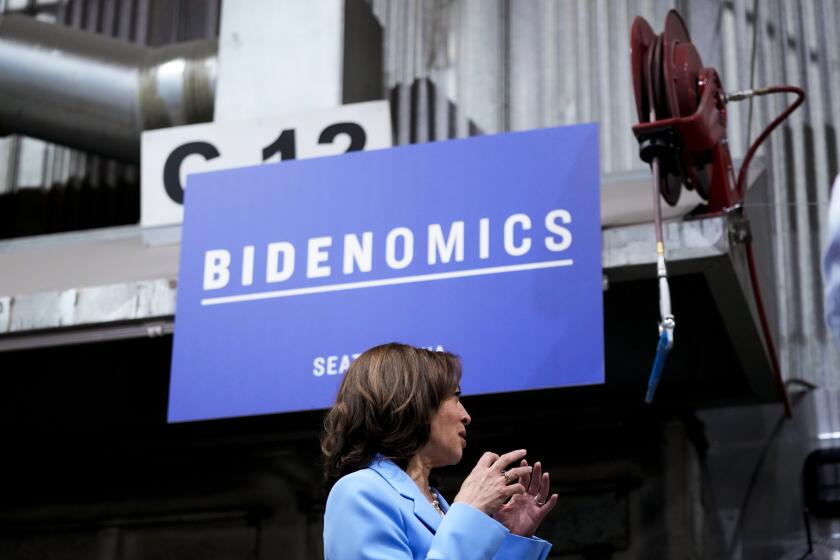Wall Street ticks higher and adds to its record high

- Share via
Most stocks rose on Wall Street Monday to build on its all-time high reached last week.
The Standard & Poor’s 500 index added 10.62 points, or 0.2%, to 4,850.43. The Dow Jones industrial average topped 38,000 points after rising 138.01 points, or 0.4%, to 38,001.81. The Nasdaq composite gained 49.32 points, or 0.3%, to 15,360.29.
Macy’s climbed 3.6% after the retailer said it rejected a buyout offer from two investment companies, in part because it didn’t offer “compelling value.” SolarEdge Technologies rose 4% after it said it would cut 16% of its workforce, and NuStar Energy jumped 18.2% after Sunoco said it would buy the pipeline and storage company in a deal valued at $7.3 billion, including debt.
They helped offset a 24.2% drop for Archer Daniels Midland, which put its chief financial officer on leave. After getting a document request from U.S. regulators, it said it’s investigating some of its accounting practices. ADM also said it expects to report profit for the full year of 2023 that’s below what analysts were forecasting.
This week will see a rush of companies reporting their results for the last three months of 2023, with roughly 70 companies from the S&P 500 on the calendar. They include American Airlines, Intel, Procter & Gamble and Tesla.
Macy’s is making the cuts as the department store chain moves to rely more heavily on automation of its supply chain and outsourcing some roles.
Analysts are expecting companies in the S&P 500 to report an overall drop in earnings for the fourth quarter, down nearly 2% from a year earlier, according to FactSet. If they’re right, it would be the fourth quarter in the last five in which profits have fallen.
After the initial week of earnings reporting season, companies that have been topping analysts’ forecasts for profits and revenue have been getting smaller bumps to their stock prices than usual, according to strategists at Bank of America.
Companies that fall short of expectations, meanwhile, have seen their stock prices get punished more than usual. It all points to “a higher bar after a big rally,” Savita Subramanian and Ohsung Kwon wrote in a BofA Global Research report.
That big rally, which carried the S&P 500 to a record for the first time in two years, came mostly on hopes that a cool-down in inflation will allow the Federal Reserve to cut interest rates several times this year. It would be a sharp turnaround from the last two years, when the Fed jacked its main interest rate drastically higher in hopes of slowing the economy enough to grind down high inflation.
Some stronger-than-expected reports on the economy recently have forced traders to push out their forecasts for when the Fed will begin cutting rates. They overall see a 43% probability that it could begin in March, down from more than 80% a week ago, according to data from CME Group.
But the expectation is still for the Fed to cut rates more this year than the three times it’s indicated.
With unemployment at historic lows and economic growth brisk, why do so many people tell pollsters the economy is bad? Is it inflation? Or politics? Biden’s future may ride on the answer.
Some upcoming reports on the economy could shift those expectations further. On Thursday, the government will give its first estimate for how strongly the economy grew during the last three months of 2023.
Economists expect it to show that the economy is still growing, but at a slower pace than during the summer. That’s exactly what the Fed wants to see, because too strong of an economy would keep upward pressure on inflation.
On Friday, the government will release the latest reading for the inflation gauge that the Fed prefers to use. Economists expect it to show that inflation held steady at 2.6% in December from a month earlier.
Treasury yields have eased significantly since October on expectations for coming rate cuts. That in turn has relaxed the pressure considerably on the stock market and helped it to climb. Yields fell further Monday.
The yield on the 10-year Treasury fell to 4.10% from 4.13% late Friday and from 5% in October.
An uptick in nationwide inflation could have bigger consequences for Californians who are already paying higher prices for basic goods and services, including housing and energy.
The two-year Treasury yield, which tends to move more on expectations for action by the Fed, ticked up to 4.41% from 4.39%.
In stock markets abroad, indexes tumbled in China as worries continue about the strength of the recovery in the world’s second-largest economy. Stocks fell 2.3% in Hong Kong to bring their loss for the year to 12.2%. Stocks tumbled 2.7% in Shanghai.
China’s commercial banks kept their loan prime rate unchanged Monday. That disappointed investors hoping for strong moves to juice China’s economy.
Japan’s Nikkei 225 did better, rising 1.6% on expectations that the Bank of Japan will keep its interest rates ultra-low following its two-day meeting that began Monday.
AP writers Matt Ott and Zimo Zhong contributed to this report.
More to Read
Inside the business of entertainment
The Wide Shot brings you news, analysis and insights on everything from streaming wars to production — and what it all means for the future.
You may occasionally receive promotional content from the Los Angeles Times.










